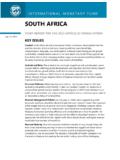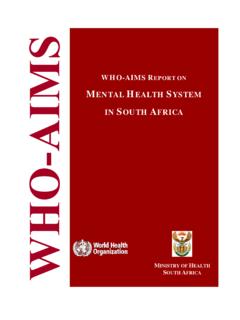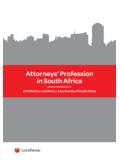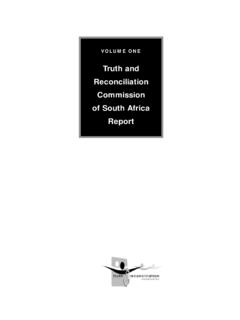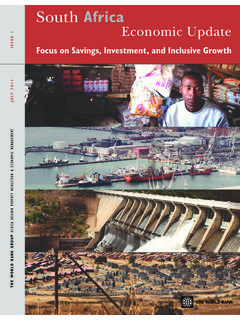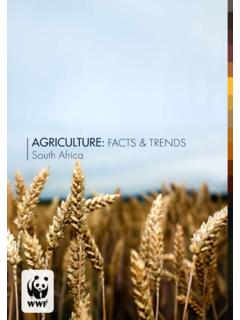Transcription of Universities Funding in South Africa; A Fact Sheet
1 1 | P a g e Universities Funding in South africa ; A Fact Sheet 1. University education as a generator of both public and private goods Universities South africa (USAf) is of the view that Universities produce public goods to the extent that university education generates new knowledge, produces research that leads to new commercial, technological, social, political and other innovations beneficial for national development. Inversely, university graduates who land better-paying jobs as a result of skills sets they bring to the labour market, reap private goods from university education.
2 Therefore, if higher education produces both collective (public) goods ( value to the country) and private goods (value to individuals), it is logical to expect that the Funding required for higher education will derive partly from the public fiscus and partly from private investment in the form of student fees or some other mechanism that may be agreed upon over time. USAf agrees with the principle of a cost-sharing model to cater for the cost of the public goods of higher education on the one hand, and that of the private goods on the other.
3 The main Funding sources of higher education therefore, are the fiscus-based state subsidy system and the private contribution (in the form of tuition fees and/or other sources of Funding ). As such a fee-free higher education system is not supported by USAf unless there is clarity on how the full higher education budget will be constructed to maintain current levels and quality of service delivery. The tuition fee and/or other sources of Funding should be at a level that allows students and their families to see sufficient value in the investment.
4 In many countries families assess the value of a degree by comparing the cost thereof to employability of the graduate. USAf takes the view that the level of public investment in higher education must be internationally benchmarked and matched to the value of the public good. If this is not done effectively, the tuition fee portion would be so large as to systematically exclude students from poor and middle class families. 2. The University sector is underfunded Government subsidies have been declining in real terms Taking into account the importance of the large national, public good projects of the higher education system, Universities have to be adequately funded.
5 However, in reality, the opposite is true. Several studies have shown that in comparison with other societies, this underfunding is considerable. The primary sources of Funding are the Department of Higher Education and Training (DHET) block grant based on the system of full-time student equivalents (FTEs) and student fees. For most Universities , 2 | P a g e state support on average accounts for more than two thirds of their unrestricted revenue. The student fee component in university budgets is typically in the region of 30-40%, an amount approaching R30 billion per annum if the cost of accommodation of students in residences is included.
6 The historic increases in tuition fees beyond CPI are a direct result of the fact that the subsidy allocation to Universities per full time equivalent student has been in decline and the fact that the higher education price index (HEPI) is approximately 2% higher than CPI. USAf generates HEPI, a measure of the inflation rate for higher education, by taking into account the typical spending patterns of Universities . For the period 2010/11 2012/13 this higher education price index was above CPI, and the index for 2013/14 - 2015/6 is currently in development.
7 The methodology used to determine HEPI is explained in the Executive Summary - Research and Development of HEPI for South africa herewith appended. Amongst the key drivers of HEPI are academic salary increases, utility costs (especially electricity), foreign exchange based expenses (book and scientific journal costs, computer hardware, software, research equipment, experimental consumables, etc.) and security and cleaning contracts. These have all grown at rates higher than CPI on an annual basis. Table 1 below provides an analysis of the government Funding for higher education through the block grant system, which is at the core of the Funding levels for teaching (and research.)
8 TABLE 1. SUBSIDY LEVELS OVER THE PERIOD 2012/2013 2014/2015. 2012/2013 2013/2014 2014/2015 2015/2016 Note No. Treasury Allocation bn bn bn bn Excluding NSFAS % Increase Above CPI (1) Block Grants bn bn bn bn % Increase CPI-linked (2) Teaching Input (TI) bn bn bn bn % Increase Below CPI (3) TI Units 1 071 822 1 119 033 1 169 143 1 222 348 (4) TI/Student Unit R10 916 R10 813 R10 863 R10 717 (5) % Increase TI/student unit growth negative (6) Teaching Output (TO) bn bn bn bn (7) TO Units 134 272 141 344 149 138 159 578 (8) TO/Student Unit R18 619 R19 102 R20 116 R20 053 (9)
9 % Increase TO/student unit growth < CPI. (10) 3 | P a g e Table 2 tells us the following: a. The National Treasury s allocation to DHET for higher education between 2012/2013 and 2015/2016 is approximately 2 percentage points above CPI throughout the period. (Row 1) b. Three factors affect this allocation as it translates to subsidies to the sector. The first is the top slicing of this allocation for various kinds of earmarked grants, which has grown annually at about the 10% level. The block grant therefore, grows at the same rate as CPI.
10 (Row 2) c. The total Teaching Input (TI) subsidy grows at a rate that is below CPI. (Row 3) d. The second factor is the annual increase in the number of students in the system. The student teaching input units grow at the rate of per annum. (Row 4) e. The third factor is that the higher education inflation rate (HEPI) is approximately higher than CPI. f. The result is a steady decline in the teaching input grant per student unit even before CPI/HEPI is taken into account. (Rows 5 and 6) g. On an annual basis therefore, there is a rapid erosion of the value of the teaching input grant per student unit.







